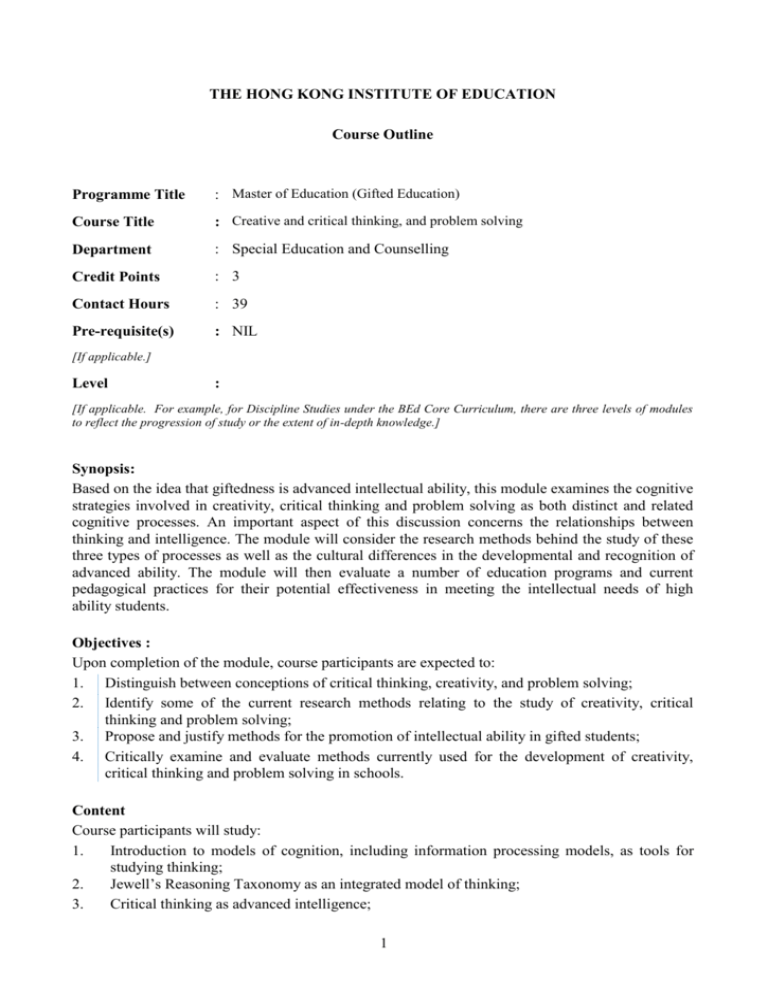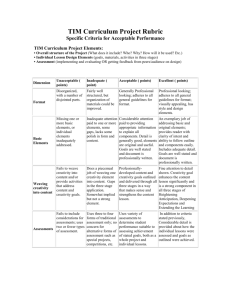
THE HONG KONG INSTITUTE OF EDUCATION
Course Outline
Programme Title
: Master of Education (Gifted Education)
Course Title
: Creative and critical thinking, and problem solving
Department
: Special Education and Counselling
Credit Points
: 3
Contact Hours
: 39
Pre-requisite(s)
: NIL
[If applicable.]
Level
:
[If applicable. For example, for Discipline Studies under the BEd Core Curriculum, there are three levels of modules
to reflect the progression of study or the extent of in-depth knowledge.]
Synopsis:
Based on the idea that giftedness is advanced intellectual ability, this module examines the cognitive
strategies involved in creativity, critical thinking and problem solving as both distinct and related
cognitive processes. An important aspect of this discussion concerns the relationships between
thinking and intelligence. The module will consider the research methods behind the study of these
three types of processes as well as the cultural differences in the developmental and recognition of
advanced ability. The module will then evaluate a number of education programs and current
pedagogical practices for their potential effectiveness in meeting the intellectual needs of high
ability students.
Objectives :
Upon completion of the module, course participants are expected to:
1. Distinguish between conceptions of critical thinking, creativity, and problem solving;
2. Identify some of the current research methods relating to the study of creativity, critical
thinking and problem solving;
3. Propose and justify methods for the promotion of intellectual ability in gifted students;
4. Critically examine and evaluate methods currently used for the development of creativity,
critical thinking and problem solving in schools.
Content
Course participants will study:
1.
Introduction to models of cognition, including information processing models, as tools for
studying thinking;
2.
Jewell’s Reasoning Taxonomy as an integrated model of thinking;
3.
Critical thinking as advanced intelligence;
1
4.
5.
6.
7.
8.
The nature and study of creativity and creative abilities, including (but not limited to),
divergent thinking, flexibility, elaboration, visualization, regression, analogical thinking,
synthesis;
The Geneplore model as an experimental approach to the study of creativity;
The nature and types of problems and their relationship to the development of expertise;
Cultural contexts of critical thinking, creativity and problem solving.
The application of creativity, critical thinking and problem solving in the classroom, including
the Future Problem Solving Programme as tools for the development of gifted students.
Assessment
a.
A research report that critically examines three research articles that deal with critical
thinking, creativity or problem solving in high ability students (2,000 words).
b.
Note: Each student will search reputable professional journals dealing with critical
thinking, creativity or problem solving and present an annotated bibliography as part of
this assignment.
A written assignment that analyzes the relationship between critical, creative thinking or
problem solving and the regular curriculum in the classroom (3,000 words).
Note: Each student will be asked to choose one topic from a list of up to ten topics in
order to complete this requirement.
Required Text
Kaufman, J. C., & Baer, J. (Eds.) (2006). Creativity and reason in cognitive development. New
York: Cambridge University Press.
Recommended Reading
Ashcraft, M. H. (2006). Cognition. Upper Saddle River, NJ: Pearson Prentice Hall.
Briggs, J. (1988). Fire in the Crucible: The Alchemy of Creative Genius. New York, St Martin's
Press.
Chi, M. T., Glaser, R., & Farr, M. J. (1988). The nature of expertise. Hillsdale, NJ: Lawrence
Erlbaum Associates.
Davis, G.A. (1986). Creativity is Forever. Dubuque, Kendall/Hunt.
Diestler, S. (2005). Becoming a critical thinker: A user friendly manual. Upper Saddle River, NJ:
Pearson Prentice Hall.
Evans, P. & Deehan, G. (1990). The Keys to Creativity. London, Grafton Books.
Finke, R. A., Ward, T. B. & Smith, S. M. (1992). Creative cognition: Theory, research, and
applications. Cambridge: MIT Press.
Gowan, J. C., & Demos, G. D., & Torrance, E. P. (1967). Creativity: Its educational implications.
New York: John Wiley and Sons.
Hayes, J. R. (1989). The Complete Problem Solver (2nd ed.) Hillsdale, NJ: Lawrence Erlbaum
Associates.
Holyoak, K. J., & Morrison, R. G. (Eds.). (2005). The Cambridge handbook of thinking and
reasoning. New York: Cambridge University Press.
Mayer, R. E. (1992). Thinking, Problem Solving, Cognition (2nd ed). New York, W.H. Freeman and
Company.
Mayer, R. E. (2005). Thinking, problem solving and cognition. UK; Freeman.
2
Ochse, R. (1990). Before the Gates of Excellence: The Determinants of Creative Genius.
Cambridge, Cambridge University Press.
Paul, R. (2006). Critical thinking: Learn the tools the best thinkers use. Upper Saddle River, NJ:
Pearson Prentice Hall.
Runco, M. A. (Ed..) (1994). Problem Finding, Problem Solving, and Creativity. Ablex, Norwood,
NJ.
Sternberg, R .J. (Ed). (1999). Handbook of Creativity. Cambridge, Cambridge University Press.
張世彗 (2003). 《創造力 - 理論、技術/技法與培育》,初版,臺北市。
周文德、 陳龍安總編輯(2003):《創意快遞 : 創造力教育資源手册》, 台北市,財團法人東
元科技文教基金會中華創造學會。
張世彗 (2003). 《創造力 - 理論、技術/技法與培育》,初版,臺北市。
陳潔華編(2004):《批判思考, 創意教學 : 香港社區教育》, 香港, 香港大學亞洲硏究中
心。
許素甘著 (2004):《展出你的創意 : 曼陀羅與心智繪圖的運用與教學》, 台北市,心理出版
社股份有限公司。
李業富、 陳家偉編著(2004):《創意教師手册》, 香港,香港天才教育協會。
胡飄等編輯(2004):《創意與批判思維教學資源選集》,香港,香港浸會大學思維工程。
陳家偉著(2005):《創意教與學》,香港,匯智出版有限公司。
張愛東著(2005):《 有效教學, 快樂探究 : 讓創意與想像放飛》, 新加坡,湯姆森學習出版
集團。
許娜娜, 吳恩澤, 劉誠編著(2005):《亞洲四地華人的創意 : 教育理論與實踐》,香港,泛太
平洋出版(香港)有限公司。
Related Websites
Nil
Related Journals
The Korean Journal of Thinking & Problem Solving
Journal of Creative Behavior
Creativity Research Journal
Critical and Creative Thinking: The Australasian Journal of Philosophy for Children.
Creative classroom
Creative Review
11 March, 2010
3









